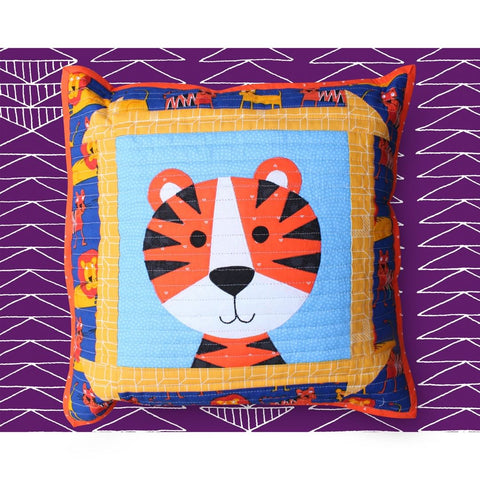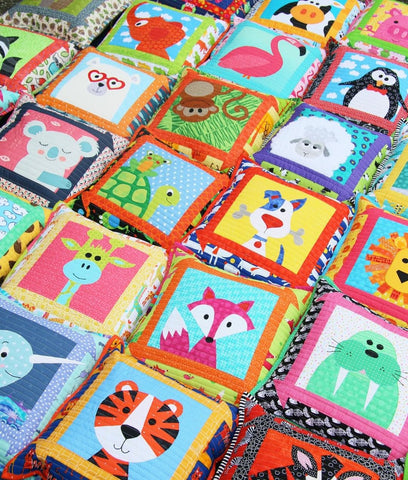
There are so many pretty fabrics and fun quilting tools we love to shop for and talk about as quilters, but interfacing probably isn't one of them. It doesn't have the pizzazz of a dreamy batik design or the punch of a high-tech iron. However, interfacing is indispensable if your quilting or sewing project requires structure. And there are many kinds of interfacing to explore, depending on the project you’re making.
So let’s talk about interfacing!
What is interfacing?

Interfacing is an additional fabric layer that adds stability, structure, and body to sewing and quilting projects. Interfacing isn’t necessary for all quilting and sewing—it’s mainly used in projects that require more shape and support.
Interfacing is fused or sewn to the wrong side of fabric before sewing your project together to create an additional layer.
Why do we use interfacing?

As mentioned above, interfacing adds stability and structure. In certain high-stress areas of garments, like shoulder seams, pockets, buttonholes, cuffs, waistbands, and hems, interfacing provides reinforcement and enables the garment to hold its shape.
Interfacing is also used in home decor projects and craft projects, like bags, pillows, or when making a t-shirt quilt (t-shirt fabric, which is quite stretchy on its own, gains stability when paired with interfacing). Interfacing is thinner than batting, so it adds a necessary stable layer to home decor without the bulk of batting.
Are there different types of interfacing?

Interfacing comes in different weaves, weights, and types. There are three main weaves of interfacing, which then differentiate further by weight and type:
What does fusible and non-fusible mean?

Fusible interfacing attaches to the back of fabric via adhesive. Adhesive has been applied to the wrong side of the fusible interfacing fabric, and is (usually) heat activated.
Fusible interfacing is great for beginners because it is very easy to use. All it takes is an iron and a little steam press to attach fusible interfacing to the wrong side of your fabric. Some fusible interfacing doesn’t require steam (we’ll get to that in a minute).
Non-fusible interfacing, otherwise known as sew-in interfacing, must be pinned in place and then sewn or basted to the wrong side of your fabric. As such, it’s not as easily applied with an iron and heat or steam.
Which interfacing should I use?
A general rule of thumb is to match the weight and thickness of your fabric to the weight and thickness of your interfacing. Barring that, it’s always a safe bet to choose an interface that is slightly lighter. Your interfacing should never be heavier than your fabric!
By Type
Non-woven interfacing can usually work for most projects, with the exception of stretchy fabrics.
Woven interfacing is great for adding body to finer weight, delicate fabrics like sheers and silks.
Knit interfacing is best for stretchy fabrics.
Fusible vs. Sew-in
Sew-in interfacing is better for synthetic materials, which may not stand up to the heat of an iron. Also, fabrics that have texture, fabrics like velvet and silk, fabrics that feature sequins, metallics, or other embellishments, fabrics with lace or mesh are all best stabilized with sew-in interfacing. If the fabric seems heat or iron sensitive, opt for sew-in interfacing!
Fusible interfacing is great for cottons, linens, and some polyesters, which can withstand the heat of an iron.
What’s your favorite interfacing?
For a long time, we opted for Pellon SF101 Shape-Flex, which is an all purpose, woven, fusible interfacing. However, after attending this year’s Sewposium we learned about B-Luxe Cotton-Woven Fusible Stabilizer and fell in love.

B-Luxe is more tightly woven, softer, sticks easily and stays flexible, and doesn’t require any steam to adhere it to the fabric!
We demonstrated in a recent Thimbles Thursday (join us every Thursday at 2:00 pm CT!) how we used B-Luxe:
If you'd like to watch Tammy assemble the applique for the front of the Zootropolis pillow, here is the starting place for the tutorial:

Interested in making the Tiger Zootropolis pillow? You’ll need the following:
- Zootrpolis Tiger Pillow Kit
- Zootropolis 1
- Applique Pressing Sheet
- B-Luxe Cotton-Woven Fusible Stabilizer

We also have other Zootropolis Pillow Kits, like the Lion and the Sheep. You can find all of our Zootropolis products here.
Do you have a favorite type of interfacing? Let us know!


